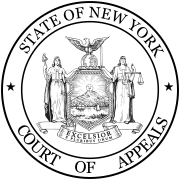Menzel v. List was a landmark restitution case involving Nazi looted art.
| Menzel v. List | |
|---|---|
 | |
| Court | New York Court of Appeals |
| Full case name | Menzel v. List |
| Argued | January 7, 1969 |
| Decided | February 26, 1969 |
| Citations | Menzel v. List, 24 N.Y.2d 91, 298 N.Y.S.2d 979, 246 N.E.2d 742 (N.Y. 1969) |
| Court membership | |
| Chief judge | ARTHUR G. KLEIN, J. |
It was filed by the widow Erna Menzel whose art collection was seized from the Menzel apartment in Brussels in 1941 after the Jewish family fled the Nazis. Menzel's attempt to recover her artworks through litigation was the first such case in the United States and is considered a landmark case that is widely cited.
The events leading up to the lawsuit
editMr. and Mrs Menzel fled the Nazis in 1941, going from Belgium to the United States. When they returned to the apartment after the end of WWII, they discovered a receipt from the Einsatzstab Rosenberg, a Nazi looting organization, for a painting by Marc Chagall called variously L'Echelle de Jacob or Le Paysan et l'Echelle or The Peasant and the Ladder or Jacob's Ladder that the Nazis had seized.[1][2]
The Menzels looked unsuccessfully for the stolen Chagall. After Mr. Menzel died in 1960, Erna Menzel continued to search. She found a mention of the Chagall in a catalog in 1962 and contacted the possessor, the American art collector Albert A. List, informing him that the artwork had been seized by the Nazis from her collection and requesting its return.[3] List, who said he had bought the painting from Perls Galleries in New York in 1955 and was unaware of its history,[4] refused to return it. Menzel filed a lawsuit, which was known as Menzel v. List. Klaus Perls, the owner of Perls Gallery, was named as a third party defendant.[5] List also filed suit against Perls. Perls, a refugee from the Nazis, and a former head of the Art Dealers' Association of America, also said he did not know that Chagall had been looted.[5][6]
Landmark lawsuit, landmark decision
editThe restitution claim was the first of its kind in the United States and as such gained considerable legal and media attention. In addition to concerning the theft of artwork by a Nazi looting organisation in a country occupied by Nazi Germany during World War II, it also posed important issues for the art world.
The New York Times called it a "classic legal domino game".[7]
In 1966, the Supreme Court of New York decided in favor of Mrs. Menzel in the first restitution case of its kind.[8][9]
Mrs Menzel's lawsuit made history and it is cited in numerous articles and books, including A Legal Primer on Managing Museum Collections and Museums in Motion: An Introduction to the History and Functions of Museums.[10][11]
References
edit- ^ "MENZEL v. LIST | 49 Misc.2d 300 (1966) | sc2d3001263 | Leagle.com". Leagle. Retrieved 2020-12-19.
- ^ Harclerode, Peter; Brendan Pittaway (2000). The lost masters : World War II and the looting of Europe's treasurehouses (1st Welcome Rain ed.). New York: Welcome Rain Publishers. pp. 236_237. ISBN 1-56649-165-7. OCLC 44266421.
- ^ Malaro, Marie C.; DeAngelis, Ildiko Pogány (2012). A Legal Primer on Managing Museum Collections. Smithsonian Institution. ISBN 978-1-58834-322-2.
- ^ "Menzel v. List". www.uniset.ca. Archived from the original on 5 December 2007. Retrieved 2020-12-19.
- ^ a b "Methodologies and Resources: Perls Galleries records, 1937-1997". Smithsonian Institution. Retrieved 2020-12-20.
Klaus was named as a third-party defendant in the 1969 World War II looted art case Menzel v. List. When Erna Menzel sued Albert List for ownership of a Chagall painting confiscated from Menzel by the Nazis, List in turn sued Perls, who had sold him the painting in 1955, having purchased it himself from an art dealer in Paris. The court awarded the Chagall painting to Menzel and ordered Perls to pay List the appreciated value of the painting.
- ^ CultureGrrl (2008-06-10). "Perls of Wisdom: Nuggets from Late NYC Dealer Klaus Perls, 96". CultureGrrl - Arts Journal. Archived from the original on 22 November 2008. Retrieved 2020-12-19.
- ^ Grant, Daniel (1987-11-29). "PERSONAL FINANCE; Collecting Art? Beware the Wrinkles (Published 1987)". The New York Times. ISSN 0362-4331. Archived from the original on 19 December 2020. Retrieved 2020-12-19.
- ^ "Owner of Chagall Painting Looted by Nazis Wins It Back in U.S. Court". Jewish Telegraphic Agency. 1965-11-17. Archived from the original on 14 November 2018. Retrieved 2020-12-19.
- ^ "Menzel v. List, 24 N.Y.2d 91 | Casetext Search + Citator". casetext.com. Retrieved 2020-12-20.
- ^ Ashton Hawkins; Richard A. Rothman; David B. Goldstein. "A Tale of Two Innocents: Creating an Equitable Balance Between the Rights of Former Owners and Good Faith Purchasers of Stolen Art" (PDF). Fordham L. Rev. Archived from the original (PDF) on 19 December 2020.
- ^ Perez-Pena, Richard (1993-10-22). "The Art-Law Center of the Universe". The New York Times. ISSN 0362-4331. Retrieved 2020-12-19.